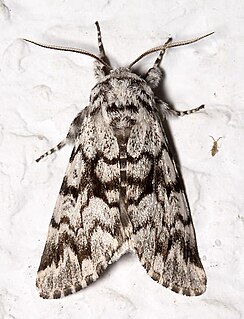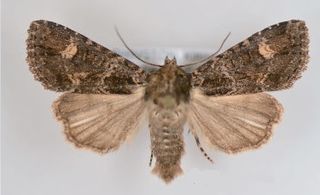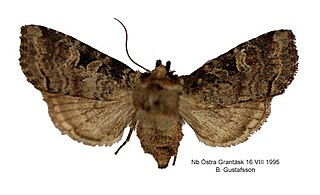
Francis Walker was an English entomologist. He was born in Southgate, London, on 31 July 1809 and died at Wanstead, England on 5 October 1874. He was one of the most prolific authors in entomology, and stirred controversy during his later life as his publications resulted in a huge number of junior synonyms.

Drasteria is a genus of moths in the family Erebidae.

Marimatha is a genus of moths of the family Noctuidae. The genus was erected by Francis Walker in 1866.

Mocis is a genus of moths in the family Erebidae. The genus was erected by Jacob Hübner in 1823.

Panthea acronyctoides, the black zigzag or tufted spruce caterpillar, is a moth of the family Noctuidae. The species was first described by Francis Walker in 1861. It is found in North America from Newfoundland to British Columbia and adjacent northern states, south in the west to Colorado, south in the east to New England and Kentucky.

Bryolymnia viridata is a moth of the family Noctuidae first described by Leon F. Harvey in 1876. It is found in the US in western California from Sonoma County north of San Francisco southward to San Diego County.

Aseptis binotata, the rusty shoulder knot moth, is a moth of the family Noctuidae. The species was first described by Francis Walker in 1865. It is found widespread in western North America, west of south-central Alberta, Wyoming, and Nebraska. Along the Pacific Coast it occurs from northern Mexico to south-central British Columbia. It can be found from sea level to altitudes over 2000 meters in a variety of habitats from dense forest to shrub desert.

Marimatha nigrofimbria, the black-bordered lemon moth, is a moth of the family Noctuidae. The species was first described by Achille Guenée in 1852. It is found in North America east of the Rocky Mountains and in Arizona and California.
Marimatha squala is a moth of the family Noctuidae first described by Clifford D. Ferris and J. Donald Lafontaine in 2010. It is found from Arizona, southward to Costa Rica.
Marimatha quadrata is a moth of the family Noctuidae first described by Clifford D. Ferris and J. Donald Lafontaine in 2010. It is found from western Texas and Arizona and southward to southern Mexico (Sinaloa).

Marimatha piscimala is a moth of the family Noctuidae first described by Clifford D. Ferris and J. Donald Lafontaine in 2010. It is found from south-eastern Texas to Arizona southward to Panama.
Marimatha tripuncta is a moth of the family Noctuidae first described by Heinrich Benno Möschler in 1890. It is found in the Caribbean and southern Florida.
Pseudomarimatha is a monotypic moth genus of the family Noctuidae. Its only species, Pseudomarimatha flava, is known from the western United States only in south-eastern Arizona and south-western New Mexico. Both the genus and species were first described by Clifford D. Ferris and J. Donald Lafontaine in 2010.

Hillia iris, the iris rover, is a species of cutworm or dart moth in the family Noctuidae. It was described by Johan Wilhelm Zetterstedt in 1839 and is found in North America.
Homorthodes dubia is a species of cutworm or dart moth in the family Noctuidae. It was described by William Barnes and James Halliday McDunnough in 1912 and is found in North America.

Lithophane grotei, commonly known as Grote's pinion or Grote's sallow, is a species of moth in the family Noctuidae. It was first described by Riley in 1882 and it is found in North America.
Brachylomia sierra is a moth in the family Noctuidae, native to North America. The species was first described by James T. Troubridge and J. Donald Lafontaine in 2007.
Neleucania patricia is a species of cutworm or dart moth in the family Noctuidae. It is found in North America.

Lacinipolia triplehorni is a species of cutworm in the family Noctuidae. It is found in North America.
Tricholita chipeta is a species of cutworm or dart moth in the family Noctuidae. It was first described by William Barnes in 1904 and it is found in North America.











